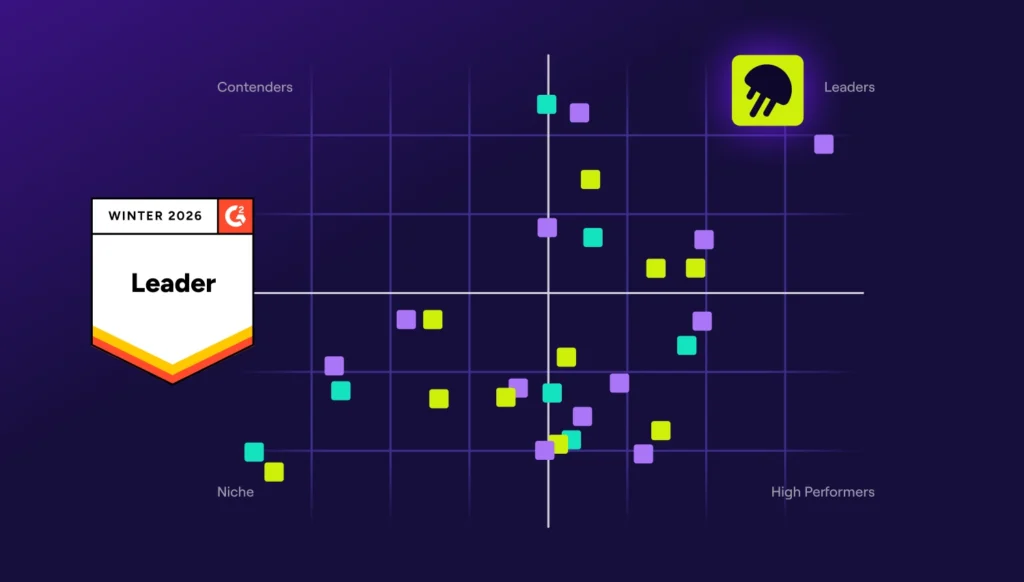To enhance engineering efficiency, organizations must embrace developer experience best practices that promote streamlined workflows and effective collaboration. Implementing Agile methodologies, encouraging knowledge sharing, and fostering cross-functional communication can elevate engineering team efficiency. Leveraging modern software development automation tools, providing adequate resources and training, and promoting a healthy work-life balance are also crucial for mitigating engineering burnout.
In essence, engineering efficiency is about optimizing your development processes and team resources to maximize output while maintaining quality and minimizing waste. This guide explains the significance of measuring engineering efficiency and how modern engineering organizations are prioritizing it.
What is Developer Productivity?
Developer productivity is the practice of evaluating how effectively and efficiently developers are able to produce high-quality code and deliver software that meets project timelines while maintaining alignment with key business objectives.
This can involve adopting agile methodologies, ensuring teams have the resources and training they need, and cultivating a communicative and collaborative environment that fosters innovation and continuous improvement.
When tracking developer productivity, it’s crucial to avoid vanity metrics – those that don’t provide meaningful insights into actual performance. Instead, focus on metrics that provide actionable insights and help you understand your team’s true performance. Examples of vanity metrics to avoid include lines of code written, coding churn, and code impact.
While efficiency is essential, it’s important to remember that software development is also a creative process. Placing too much emphasis on efficiency metrics can stifle innovation. Leaders must strike a balance between fostering creativity and driving efficiency to build high-performing development teams.
The Right Way to Measure Engineering Productivity
Measuring software engineering efficiency and productivity is a complex process that requires a holistic approach in order to capture the multifaceted nature of the software development lifecycle. Measuring and optimizing engineering productivity has historically been challenging due to the potential pitfalls of hyper-fixating on to few or incorrect metrics, but with the right approach, organizations can gain valuable insights into their engineering performance.
To measure engineering productivity effectively, organizations have to go beyond superficial metrics and consider a comprehensive range of engineering productivity metrics. This includes evaluating not only individual output but also team members’ collaboration, code quality, and the ability to satisfy customer requirements. By considering these broader aspects, businesses can gain a more accurate understanding of the bigger picture in terms of their engineering efficiency. Ultimately, how to measure engineering performance in a way that works for your organization may differ widely from businesses in other industries.
Metrics for Measuring the Software Development Process
To best understand the big picture of software productivity in software engineering, organizations must understand how to measure software engineering productivity and how to measure software engineer performance.
Two widely recognized frameworks that can guide organizations in measuring software engineering productivity are the DORA metrics and SPACE Framework.
The DORA (DevOps Research and Assessment) metrics, developed by the DevOps Research and Assessment organization, focus on evaluating software delivery productivity, especially within the context of DevOps practices. These metrics generally include deployment frequency, change lead time, mean time to recover, and change failure rate.
Let’s take a closer look at each:
- Deployment Frequency. This metric measures how often your team releases code to production. Higher deployment frequency is generally better, as it indicates that your team can deliver value to users quickly and respond to changes efficiently. Frequent deployments often go hand-in-hand with practices like continuous integration and continuous delivery (CI/CD).
- Lead Time for Changes. Lead time for changes measures how long it takes for a code change to go from commit to production. A shorter lead time means faster feedback loops and quicker delivery of new features or bug fixes. This metric helps identify bottlenecks in your development process.
- Change Failure Rate. This metric tracks the percentage of deployments that cause a failure in production. A lower change failure rate indicates higher quality and stability in your releases. It’s a measure of how effectively your team can deliver changes without introducing issues.
- Time to Restore Service. Time to restore service (also known as Mean Time to Recovery or MTTR) measures how long it takes your team to recover from a production failure. A shorter time to restore service demonstrates your team’s ability to quickly identify and resolve issues, minimizing downtime and impact on users.
The SPACE Framework, conversely, provides a broader perspective by encompassing multiple dimensions of software engineering productivity. SPACE is an acronym that highlights its key factors: Satisfaction, Performance, Activity, Communication and collaboration, and Efficiency.
In addition to the DORA metrics and SPACE Framework, there are numerous other metrics for measuring the development process, such as defect density, code coverage, customer satisfaction, and employee engagement. These metrics divulge information about the quality of the code, testing effectiveness, customer feedback, and even team morale.
To effectively measure software engineering productivity and engineering performance, organizations should select metrics that align with overall business goals and context. Businesses must strike a balance between quantitative metrics and qualitative assessments to make better-informed decisions for process improvement and resource allocation.
How to Measure Engineering Quality
Measuring engineering quality is essential to ensure the effectiveness and reliability of the software engineering process. To successfully measure engineering prowess, organizations must focus on engineering metrics that matter to them and align with their underlying objectives.
These metrics may include bugs, time to resolution, and uptime. Various engineering metrics tools, including the Jellyfish Engineering Management Platform, can aid in measuring engineering quality. These tools provide automated tracking, analysis, and visualization of metrics, simplifying the measurement process.
Similarly, organizations must understand how to measure engineering team performance, as measuring engineering team performance requires a deft combination of quantitative and qualitative assessments. Key performance indicators for design and engineering can include metrics such as on-time project delivery, customer feedback ratings, defect resolution time, and team velocity.
Effective software engineering metrics and quality engineering KPI provide vital insights into the performance and capabilities of your existing development processes.
Key Performance Indicators for Engineering Leaders
By utilizing the most appropriate and informative KPIs, organizations can gain valuable insights into the effectiveness and efficiency of their engineering efforts, identify areas for improvement, and make data-driven decisions. To ensure you’re measuring against relevant standards, it’s essential to establish clear benchmarks for your KPIs.
An engineering KPI dashboard, supported by the latest engineering metrics tools, can provide a robust, comprehensive view of performance and enable continuous monitoring and evaluation. Engineering Management Platforms (EMPs) facilitate the aggregation, analysis, and visualization of these key metrics.
Key performance indicators for the engineering department should help an organization meet or exceed operational objectives and the specific goals of the engineering team. For example, to effectively track progress and maintain alignment with the roadmap, engineering leaders should utilize project management tools and methodologies like Scrum. This allows teams to break down work into smaller, manageable tasks, track progress effectively, and adapt to changing requirements.
Improve Engineering Efficiency with Jellyfish
Jellyfish is an Engineering Management Platform (EMP) designed to help organizations gain visibility into their engineering operations, improve efficiency, and align engineering work with business goals. Here’s how Jellyfish can help your team:
Gain Visibility into Engineering Work

Jellyfish provides a clear view of what engineering teams are working on and how that work connects to broader business objectives. By integrating with tools like Jira and Git, Jellyfish creates a centralized hub for tracking engineering activity, providing insights into how time is spent across different project management initiatives, and types of work (e.g., new features, bug fixes, tech debt). This transparency helps identify potential bottlenecks and optimize resource allocation. Additionally, Jellyfish helps to uncover inefficiencies within workflows by providing detailed data on how time is spent and where resources are being allocated.
Track and Improve Deliverable Progress

With Jellyfish, you can monitor the progress of key initiatives and deliverables in real-time. This allows you to identify potential roadblocks early on and make proactive adjustments to keep projects on track. By visualizing progress and identifying trends, you can ensure that teams are shipping on schedule and meeting their commitments.
Improve Team Performance

Jellyfish helps you measure and improve the efficiency of your engineering teams by tracking key metrics like cycle time, deployment frequency, and code churn. By understanding these metrics, you can identify areas for improvement, implement process changes, and foster a culture of continuous improvement. Jellyfish also helps track developer satisfaction and identify potential burnout risks, allowing you to create a more supportive and productive environment.
Align Engineering with Business Goals

One of Jellyfish’s core strengths is its ability to connect engineering work with business objectives. By providing a clear line of sight between engineering activities and their impact on business outcomes, Jellyfish helps ensure that engineering teams are focused on the most valuable work. This alignment fosters better collaboration between engineering and other departments, leading to more effective decision-making and improved business results.
Reduce Technical Debt

Jellyfish helps you track and manage technical debt, allowing you to proactively address issues that can hinder development velocity and create future problems. By visualizing the accumulation of technical debt and its potential impact, you can prioritize refactoring efforts and allocate resources effectively to maintain a healthy codebase.
Ready to see Jellyfish in action?
Take a product tour to explore these features and discover how Jellyfish can help your engineering team work smarter, feel empowered, and deliver better outcomes.





